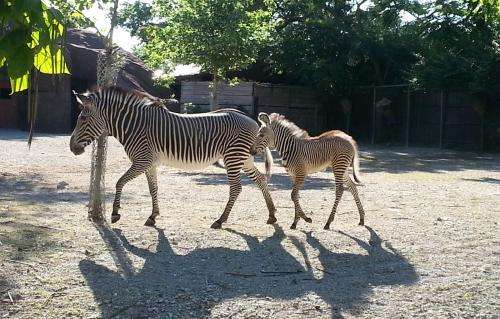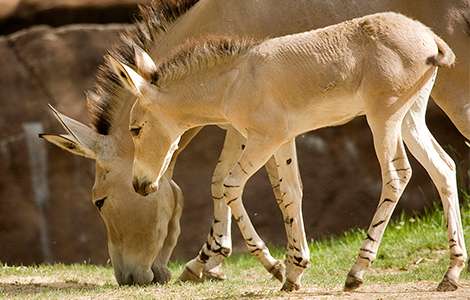Baby zebra is latest success in research partnership

The recent birth of a female Grevy's zebra foal at the Saint Louis Zoo marks another milestone in a long-running Washington University in St. Louis research partnership that is making significant contributions to the preservation of Grevy's zebra and the equally endangered African wild ass.
"Washington University joined forces with Saint Louis Zoo researchers nine years ago for a study that compares African wild asses and Grevy's zebra in an effort to better understand the relationship between species behavior and the likelihood of domestication," said Fiona Marshall, PhD, professor of anthropology in Arts & Sciences.
The research partnership grew out of a mutual need.
Marshall, an expert on the early origins of animal domestication, has conducted extensive research on the domestication of donkeys. Since ancient populations of African Wild ass were ancestors of donkeys, she wanted to learn more about the behavior of African wild asses to inform her work on domestication.
Cheryl Asa, PhD, director of research at the Saint Louis Zoo, was interested in any research that would support the zoo's efforts to improve the captive breeding prospects of the endangered zebra and wild ass being cared for at the zoo.
"A zoo setting is a good analogy for many aspects of early domestication, and with wild animals held in captivity, breeding is always a key goal," Marshall said.
A key focus of the research is seeking an explanation for a mysterious difference in the domestication history of the Grevy's Zebra and the African wild ass.

While almost all large domesticated mammals have wild ancestors who lived in herds with highly social behaviors and well-defined hierarchical relationships, neither wild asses nor Grevy's is reported to be social in the wild. The key question here is why was one domesticated and the other not?
In 2011, Marshall, Asa and Martha Fischer, curator of mammals/ungulates at the Saint Louis Zoo, published a paper in Zoo Biology on the behavior of the Somali wild ass. In 2012, Marshall and Asa published an article on their research in the Journal of Archaeolgical Method and Theory titled "A Study of African Wild Ass Behavior Provides Insights into Conservation Issues, Domestication Processes and Archaeological Interpretation."
Based on observations of a group of three young female Somali wild asses at the Saint Louis Zoo, the study provides new insight into the species' social behavior in a captive setting—a relatively good proxy environment for the early phases of wild animal domestication.
The most unexpected finding in the first Saint Louis Zoo study was that, even though the young females displayed a preference for maintaining close proximity with one another, the frequency and extent of low-intensity aggressive interactions among them was rather high, rather like bickering among sisters.
Generally, the study suggests that wild ass behavior is somewhat flexible and that captivity may allow them to express behaviors they might not have the opportunity to display in the wild, which provides insight into their potential for sociality. The study is now providing exciting insights into group dynamics over the longer term.
While the research contributes to the goals of both archaeology and conservation biology, it also is providing an interesting and fun learning environment for a new generation of researchers.
Marshall and Asa serve as advisers to teams of zoo interns who record detailed observations of animal behavior for the research project. Marshall takes WUSTL students to the zoo to observe equid behavior as part of an undergraduate research course she teaches called "Bones to Behavior." Asa has taught a spring semester evening course on animal behavior for about 20 years in WUSTL's University College in Arts & Sciences.
The group effort, it seems, also is paying off for the endangered equids.
In addition to the female Grevy's zebra foal born June 22, the Saint Louis Zoo celebrated the birth last fall of five Somali wild ass foals. These births and several earlier ones mark a significant addition to the zoo population of these critically endangered animals.
Conservation groups estimate that wild populations of both equids have dwindled to a few thousand individuals, with fewer than 1,000 African wild ass thought to be living in Eritrea, Ethiopia and Somalia, and less than 2,500 Grevy's zebra living in Kenya and Ethiopia.
In 2012, the zoo and its partners received national recognition from the Association of Zoos and Aquariums for wildlife conservation work on Grevy's Zebras, which it cited as a model collaborative endangered species conservation program.
Provided by Washington University in St. Louis


















